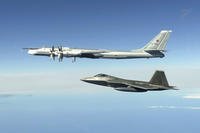Fleets of electric vehicles ready to shoulder the military's workload and slash greenhouse gas emissions over the coming decade -- that's what the Pentagon is hoping it can pull off as part of President Joe Biden's efforts to combat climate change, Deputy Defense Secretary Kathleen Hicks said Monday.
Tactical vehicles will first go hybrid, using a mix of fossil fuels and electricity, before making a full transition, while about 170,000 non-tactical cars and trucks used on military bases could go right to electric, Hicks said while touting the climate initiatives at Wayne State University in Michigan.
"Electric vehicles are quiet. They have a low heat signature and incredible torque, and because they tend to be low maintenance with fewer moving parts, they have the potential to reduce logistics requirements," she said.
Read Next: Troops with Family Trapped in Afghanistan Get Extraction Help Offer from Pentagon
It's an ambitious initiative. The military's non-tactical vehicle fleet alone is the second largest in the federal government next to the U.S. Postal Service, while the Defense Department is by far the largest user of fossil fuels due in part to its tactical vehicle fleet.
The Army has more than 242,000 tactical wheeled vehicles such as the Humvee, according to the Government Accountability Office.
The proposed shift echoes the Navy's Great Green Fleet plans a decade ago under the Obama administration, which was similarly focused on reducing greenhouse gases and climate change.
Under Navy Secretary Ray Mabus, the service spent about seven years trying to adapt ships and aircraft to run on domestically supplied biofuels -- which are made from plants such as corn and animal fat and waste such as manure -- instead of conventional fossil fuels. But dropping oil prices and limited supplies of the alternative fuels left the Great Green Fleet with limited reach when President Barack Obama left office in 2017.
Mabus, a former Democratic governor of Mississippi, had set a goal in 2009 that the Navy and Marine Corps would get 50% of their fuel from alternative sources by 2020. He said reducing dependence on oil would mean fewer risky fuel convoys on the battlefield and give the U.S. a tactical advantage.
Hicks couched the new push under Biden in similar language, saying electric vehicles will expand military capabilities but also come with technical hurdles that will require help from civilian industry.
The Army Ground Vehicle Systems Center in Warren, Michigan, is developing a new micro-grid technology that could provide power to future hybrid or electric vehicles on the battlefield, Hicks said.
The auto industry in Detroit and elsewhere has been moving toward hybrid and electric engines for years, proof that the technology has matured enough to be profitable. General Motors announced earlier this year it will eliminate gasoline models by 2035, and nearly all major manufacturers in the world plan to partly shift to hybrid and electric, or at least roll out new models.
Cutting-edge military research and the auto industry's commercial breakthroughs in new electric vehicles will be key to the Pentagon's plans, especially in lithium ion battery technology. "We need partners," Hicks said.
The lithium ion batteries so crucial to hybrid and electric cars and trucks now create two major challenges. Disposal of the toxic materials could be a major environmental issue, effectively trading greenhouse gas emissions for other pollution. And China, the top U.S. adversary, controls the global supply.
China reportedly produces about two-thirds of the batteries. The Biden administration and members of Congress have been scrambling to boost U.S. production and domestic mining of materials to make the components, after Beijing rose to global dominance in solar power a decade ago through heavy investment.
Success for Biden's climate agenda could depend partly on the race for the battery market, as well as the larger trend toward electric vehicles. The Defense Department could add significant weight to the push.
"There does need to be an effort to make sure that there's a market signal sent, so that that can be mined and processed here," Hicks said. "That's part of what we are trying to do on the Defense Department's side is raise the national security flag to indicate our interests in that."
-- Travis Tritten can be reached at travis.tritten@military.com. Follow him on Twitter @Travis_Tritten.
Related: Army Takes First Step Toward Equipping Tactical, Combat Vehicles with Electric Engines












